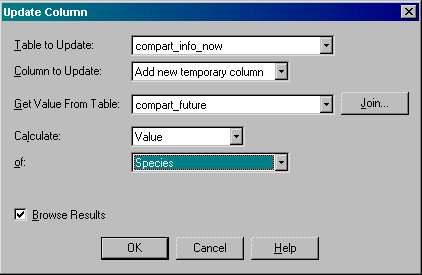Using a GIS for planning and projections


In this practical you will:
You will need:
- Your zip disk containing data used in the practicals so far
- MapInfo software (at least version 5.5)
- Microsoft Excel
|
|
Open Microsoft Excel. Open your original file compart_info.xls with data you entered based on your fieldwork. If you simply update the worksheet and try and open it again in MapInfo as a Microsoft Excel worksheet all the information you added to the table , i.e. the compartment boundaries will be lost. If however you update the excel file and then open the corresponding MapInfo table compart_info.TAB the updates will not be visible. Instead, create new columns in compart_info.xls Once you have made your projections and make predictions for your management plan, enter this information in the empty columns in compart_future.xls and save the file.
Make a note of the range of cells that are filled with data. Now close compart_future.xls. You're now ready to update the information into MapInfo.
|
|
Open MapInfo and in the start up dialogue box, select Open Workspace and open compart.WOR. You should find that the following MapInfo files are open: compart_info_now.TAB; features.TAB; and Little_Wittenham.TAB.
Now you will need to open the file with your predictions. Select the File menu and Open Table.... Under Files of type: remember to select Microsoft Excel and under Preferred View: select Browser. Open compart_future.xls. In the Excel Information dialogue box under Named Range: select Other... and enter the range that you want to import. Don't forget to select Use row above selected range for column titles. Click OK.
You should now be able to see compart_future in a new browser window. Check all the information you entered is there.
|
|
Click on the title bar on the compart_info_now browser window. Then select the Table menu and Update Columns.... In the Update Columns dialogue box in the Table to Update: entry select compart_info_now. In the Get Value from Table: entry select compart_future. Once you have selected another table to update values from, a few more options will become available to you in the dialogue box. Under Column to Update: choose add new temporary column. Click on the Join... button.
|

|
In the Specify Join... dialogue box for Where: choose Compartment_no (From Table: compart_info_now), under matches select Compartment_no (From Table: compart_future). Click OK.
|

|
Back in the Update Columns dialogue box in the remaining fields, under Calculate: select Value, under Of: select species_5. Make sure Browse results box is ticked. Click OK.
A new browser window should be visible called compart_info_now Browser:2. Repeat the column update process for species_20 and your predictions for 20 years in the future. This should produce another browser window called compart_info_now Browser:3.
Save the updated table by selecting File menu, Save Copy As... and choosing compart_info_now and the new name as future_info.TAB. Now you can close compart_info_now (using File, close table...) and the other browsers and then open future_info (using File, open table...) twice in both the browser and current mapper windows.
Now you can create a thematic map (see Practical 5) for the future composition of Little Wittenham in 5 years and 20 years. You can also add information to features.TAB e.g. access roads, and include another layer in the workspace. You will need to print off a map with the results and management operations for a single year (including areas allocated to planting, thinning, weeding, felling, position of access routes etc.) for 5 years in the future and 20 years. Finally, produce a summary costing of these operations at current prices.
|
|
Top of page
|




